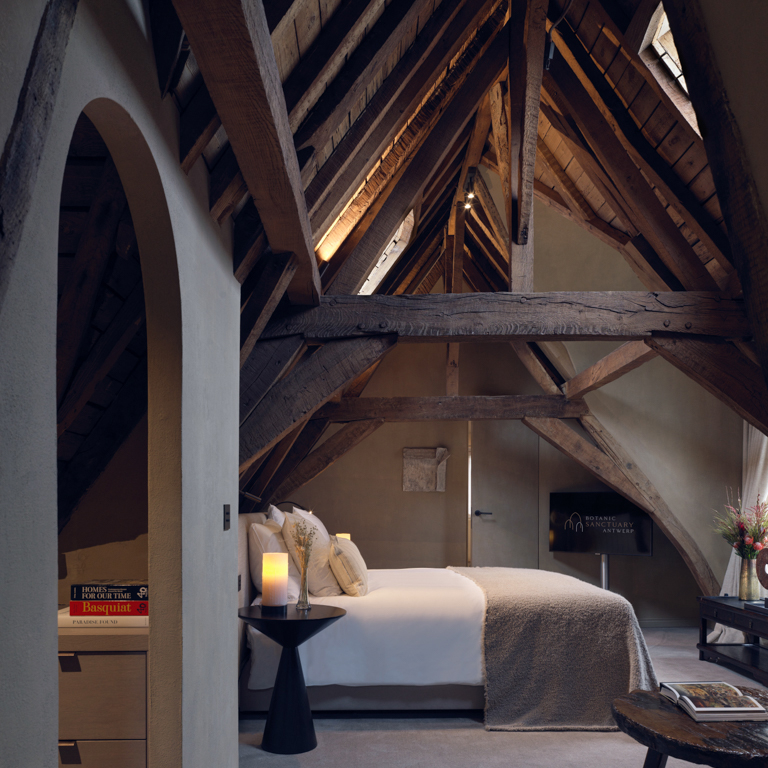There are few bolder examples of the architectural juxtaposition of old and new than Zaha Hadid’s Port House, in Antwerp, Belgium. I first spied this astonishing sight through the window of a speeding train from Amsterdam: a zeppelin plunked on top of an ancient firehouse like a pixilated ship steaming to the North Sea, or a semi-cut diamond with mirrored windows for facets.
Both interpretations reflect Antwerp’s position as the second-largest seaport in Europe, behind Rotterdam. For seven centuries, it has also been the world’s diamond capital. But rather than coast on its established glories, Antwerp is using its background as a catalyst to propel the city’s narrative forward.
Until the late 1500s, the city and its traders amassed fortunes from gemstones, precious metals, wool, and silk that poured in from Africa, Asia, and the Americas. “Notwithstanding Paris, you would not find a richer city north of the Alps, nor one as powerful,” wrote Florentine merchant Lodovico Guicciardini, who chronicled Antwerp’s golden age in the book Description of the Low Countries. Here, Rubens, Bruegel, Van Dyck, and Nicolaas van Eyck flourished under the patronage of foreign rulers.

In 1663, the Royal Academy of Fine Arts was founded under Philip IV, the Netherlands’ Spanish king. When Vincent van Gogh was a student there, he fended off hunger pangs by contemplating Rubens’s technique in the many repositories of the Flemish master’s works. Centuries later, Belgian fashion designers Dries Van Noten, Ann Demeulemeester, Marina Yee, and others became known as the “Antwerp Six,” and ushered in a new era of Flemish avant-garde. Later, Raf Simons, Martin Margiela, Olivier Theyskens, and Haider Ackermann would continue in this rich tradition.
Today, Antwerp’s medieval streets thrum with neon-bright flashes of color and pattern, creating a palpable style vanguard. Dries Van Noten’s flagship, Modepaleis, is located in what had been a haberdashery dating back to 1881; now the designer’s new beauty line is displayed in its original wooden cases.
Despite being a sophisticated international hub, Antwerp is often overshadowed by its neighbors, bureaucratic Brussels, ultra-hip Amsterdam, and even cinematic Bruges. The average resident speaks about six languages, and though the people are hugely productive, “nowhere in Europe do they appreciate leisure like they do in Antwerp,” says my adult son, who lived there for six months during the pandemic. It’s a paradigmatic European metropolis—cobblestones, gilded public spaces, glamour, and coffee cups chiming all over town. In Antwerp, even a committed wine drinker can love a chilled Trappist ale in a tulip glass.

Architecturally, Antwerp is a Gothic–Flemish Renaissance–and–Baroque jewel of a place along the Schelde, the river that launched the ships that carried back the world. “Antwerp likes to show off,” said my guide, Ariane Van Duytekom, as we stood in Grote Markt, looking up at the gold-encrusted City Hall, the mayor’s office since 1564.
With the recent reopening of the Royal Museum of Fine Arts, or KMSKA, after an 11-year renovation, Antwerp’s days of being undervalued by worldly travelers may be fading. Here, the city’s trademark past-meets-future aesthetic has stunning twists. A Dalí landscape is hung beside a Bruegel Tower of Babel; a bright-white Stairway to Heaven connects two galleries, one of which soars with Rubenses. Like the city itself, writes general director Carmen Willems, “the renewed museum offers two worlds in one.”
And to crown its renaissance, Antwerp has its first five-star hotel. Botanic Sanctuary covers more than 200,000 square feet in the center of town. Despite its sprawling footprint, it was hard to locate the entrance, and I found myself in the titular botanical gardens, which, for centuries, provided herbal remedies. Besides a monastery, many of the buildings once contained hospitals and infirmaries. The old apothecary is now an outpost for the spa’s Austrian-made, holistic formulations.

With its historical bones, modern infrastructure, and high style, the hotel may be redefining the urban respite. “Every kind of luxury is in our little village, and all under one roof,” says managing director Marc Alofs. The hotel’s lavish but minimalist three-story destination spa is the only entirely new section. There, guests can swim laps while watching night fall over the gardens through the sloped glass roof.
There are also meditation spaces, a 15th-century chapel with frescoes that were uncovered during renovations, six winter gardens, and even six illustrious chefs that oversee six gastronomic restaurants, which are rapidly accumulating Michelin stars. At Het Gebaar, a gingerbread-type house whose interior is a model of contemporary Antwerp flair, I skipped lunch and opted for a pastry, devouring one of chef Roger van Damme’s buttery mille-feuilles wrapped in bangles of gold sugar.
Just a 30-second walk from the hotel’s entrance lies Museum Mayer van den Bergh, the home of Pieter Bruegel the Elder’s 1542 masterpiece, Mad Meg. This allegorical portrait of chaos and turmoil could be studied for days. Its proximity seemed apt: so near this hotel, in this city so tied to its past and yet so oriented toward its future. “This place could only be in Antwerp,” said spa director Xavier Le Clef. “Others have beaches, forests, mountains. But we have our culture, which nobody can top.”
Marcia DeSanctis is a Connecticut-based writer. She recently published her second book, a collection of travel essays called A Hard Place to Leave: Stories from a Restless Life

